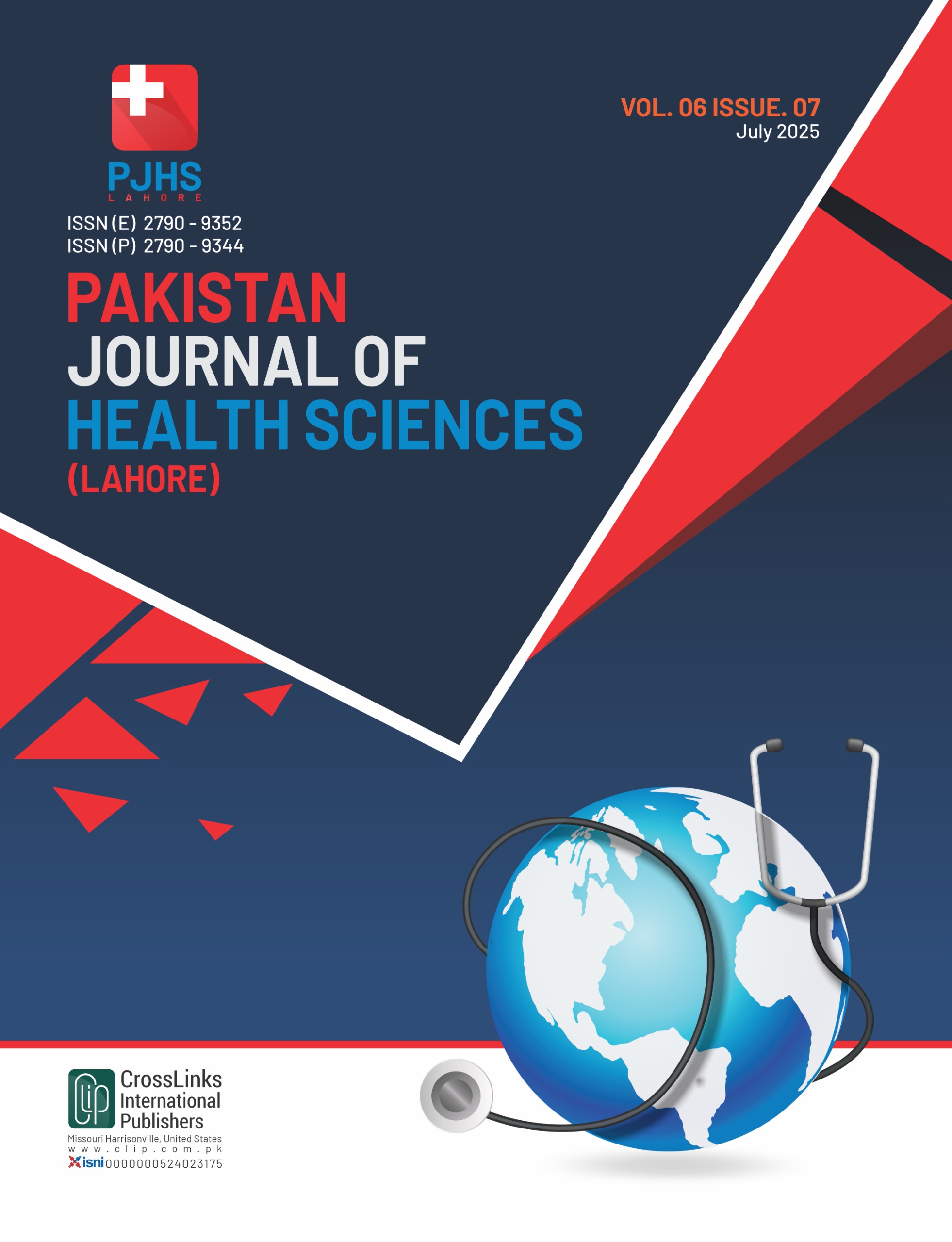Histopathological Diversity in Hysterectomy Specimens at Jinnah Sindh Medical University Lab
Histopathological Diversity in Hysterectomy Specimens
DOI:
https://doi.org/10.54393/pjhs.v6i7.3167Keywords:
Hysterectomy, Histopathological Diversity, Abnormal Uterine Bleeding, Nabothian CystAbstract
Hysterectomy is common but often overused in Pakistan, with rising cases in cities like Dera Ghazi Khan. Fibroids and abnormal uterine bleeding are the top causes, though many effective non-surgical treatments exist. Experts urge prioritizing medical management and preserving fertility through alternatives like myomectomy before resorting to surgery. Objective: To determine the spectrum of hysterectomies’ lesions in histopathological analysis at Jinnah Sind Medical University Lab (JSMU lab). Method: This retrospective study was conducted in the setting of the JSMU diagnostic lab in Karachi, from January 2023 to December 2024. The sample size included the hysterectomy samples received during the two years mentioned before. The sampling technique was non-probability consecutive sampling. A proforma was designed to collect data from the records of the JSMU lab. This included the age of the patients, Indication of surgery, and outcome/diagnosis after histopathological examinations. Results: This study included 147 hysterectomies with a mean age of 44.11 years, and the Individuals aged between 40 and 49 years comprised the largest proportion, making up half of the total participants. Heavy menstrual bleeding was the most frequent clinical finding, present in 44% of cases. Histopathologically, 50% of cases showed leiomyoma, followed by adenomyosis, with almost all patients having chronic cervicitis and nabothian cysts. Conclusions: It was concluded that hysterectomy was most common in women aged 40–49 years, primarily for heavy menstrual bleeding. Leiomyoma was the leading histopathological finding, followed by adenomyosis, with chronic cervicitis and nabothian cysts in most cases.
References
Anbreen F, Qadir S, Naeem H, Farhat N, Ghafoor M, Hassan S. Type, time-trend and indications of hysterectomy. Gomal Journal of Medical Sciences. 2018 Dec; 16(4): 92-6. doi: 10.46903/gjms/16.04.1958. DOI: https://doi.org/10.46903/gjms/16.04.1958
Wright JD, Huang Y, Li AH, Melamed A, Hershman DL. Nationwide estimates of annual inpatient and outpatient hysterectomies performed in the United States. Obstetrics and Gynecology. 2022 Mar; 139(3): 446-8. doi: 10.1097/AOG.0000000000004679. DOI: https://doi.org/10.1097/AOG.0000000000004679
Naseeb S, Dossal A, Rashid S. An Audit of Hysterectomy at Jinnah Postgraduate Medical Centre, Karachi. Journal of The Society of Obstetricians and Gynaecologists of Pakistan. 2021 Jun; 11(2): 95-9.
Don EE, Mijatovic V, Huirne JA. Infertility in patients with uterine fibroids: a debate about the hypothetical mechanisms. Human Reproduction. 2023 Nov; 38(11): 2045-54. doi: 10.1093/humrep/dead194. DOI: https://doi.org/10.1093/humrep/dead194
Mension E, Calaf J, Chapron C, Dolmans MM, Donnez J, Marcellin L et al. An update on the management of uterine fibroids: personalized medicine or guidelines? Journal of Endometriosis and Uterine Disorders. 2024 Sep; 7: 100080. doi: 10.1016/j.jeud.2024.100080. DOI: https://doi.org/10.1016/j.jeud.2024.100080
Vitale SG, Della Corte L, Ciebiera M, Carugno J, Riemma G, Lasmar RB et al. Hysteroscopic endometrial ablation: from indications to instrumentation and techniques—a call to action. Diagnostics. 2023 Jan; 13(3): 339. doi: 10.3390/diagnostics13030339. DOI: https://doi.org/10.3390/diagnostics13030339
Davis E and Sparzak PB. Abnormal uterine bleeding [Updated 2023 Sep 4]. StatPearls. Treasure Island (FL): Stat Pearls Publishing. 2024.
Fergusson RJ, Rodriguez MB, Lethaby A, Farquhar C. Endometrial resection and ablation versus hysterectomy for heavy menstrual bleeding. Cochrane Database of Systematic Reviews. 2019 Aug; 8. doi: 10.1002/14651858.CD000329.pub3. DOI: https://doi.org/10.1002/14651858.CD000329.pub3
Cruz SD, Santos VC, Nunes EF, Rodrigues CN. Sexual Function and Stress Urinary Incontinence in Women Submitted to Total Hysterectomy with Bilateral Oophorectomy. Fisioterapia e Pesquisa. 2020 Apr; 27: 28-33. doi: 10.1590/1809-2950/18033627012020. DOI: https://doi.org/10.1590/1809-2950/18033627012020
Forsgren C, Amato M, Johannesson U. Effects of Hysterectomy On Pelvic Floor Function and Sexual Function—A Prospective Cohort Study. Acta Obstetricia et Gynecologica Scandinavica. 2022 Oct; 101(10): 1048-56. doi: 10.1111/aogs.14437. DOI: https://doi.org/10.1111/aogs.14437
Ekanayake C, Pathmeswaran A, Herath R, Wijesinghe P. Vaginal, Sexual and Urinary Symptoms Following Hysterectomy: A Multi-Centre Randomized Controlled Trial. Women's Midlife Health. 2020 Mar; 6(1): 1. doi: 10.1186/s40695-020-0049-2. DOI: https://doi.org/10.1186/s40695-020-0049-2
Erdoğan E, Demir S, Çalışkan BB, Bayrak NG. Effect of Psychological Care Given to the Women Who Underwent Hysterectomy Before and After the Surgery on Depressive Symptoms, Anxiety and the Body Image Levels. Journal of Obstetrics and Gynaecology. 2020 Oct; 40(7): 981-7. doi: 10.1080/01443615.2019.1678574. DOI: https://doi.org/10.1080/01443615.2019.1678574
Sharara FI, Kheil MH, Feki A, Rahman S, Klebanoff JS, Ayoubi JM et al. Current and Prospective Treatment of Adenomyosis. Journal of Clinical Medicine. 2021 Jul; 10(15): 3410. doi: 10.3390/jcm10153410. DOI: https://doi.org/10.3390/jcm10153410
Stratopoulou CA, Donnez J, Dolmans MM. Conservative Management of Uterine Adenomyosis: Medical Vs. Surgical Approach. Journal of Clinical Medicine. 2021 Oct; 10(21): 4878. doi: 10.3390/jcm10214878. DOI: https://doi.org/10.3390/jcm10214878
Uwais A, Al-Abadleh A, Jahameh M, Satari A, Al-Hawamdeh Q, Haddadin S. A Comparison Between Total Abdominal Hysterectomy Versus Total Laparoscopic Hysterectomy. Gynecology and Minimally Invasive Therapy. 2024 Jan; 13(1): 43-7. doi: 10.4103/gmit.gmit_72_23. DOI: https://doi.org/10.4103/gmit.gmit_72_23
Ciebiera M, Madueke-Laveaux OS, Feduniw S, Ulin M, Spaczyński R, Zgliczyńska M et al. GnRH Agonists and Antagonists in Therapy of Symptomatic Uterine Fibroids–Current Roles and Future Perspectives. Expert Opinion on Pharmacotherapy. 2023 Nov; 24(16): 1799-809. doi: 10.1080/14656566.2023.2248890. DOI: https://doi.org/10.1080/14656566.2023.2248890
Donnez J, Squifflet J, Polet R, Nisolle M. Laparoscopic Myolysis. Human Reproduction Update. 2000 Nov; 6(6): 609-13. doi: 10.1093/humupd/6.6.609. DOI: https://doi.org/10.1093/humupd/6.6.609
Ng AP, Sanaiha Y, Bakhtiyar SS, Ebrahimian S, Branche C, Benharash P. National analysis of cost disparities in robotic-assisted versus laparoscopic abdominal operations. Surgery. 2023 Jun; 173(6): 1340-5. doi: 10.1016/j.surg.2023.02.016. DOI: https://doi.org/10.1016/j.surg.2023.02.016
Davis AA. Unindicated Hysterectomies in India: The Aftermath. British Medical Journal Case Reports CP. 2019 Dec; 12(12): e230129. doi: 10.1136/bcr-2019-230129. DOI: https://doi.org/10.1136/bcr-2019-230129
Khandelwal S. Comprehending Unwanted Hysterectomies in Developing Nations: An Analysis of Women’s Decision-Making Processes, Underlying Causes, and Subsequent Consequences. Annals of Medicine and Surgery. 2024 Nov; 86(11): 6404-6. doi: 10.1097/MS9.000000000000264 DOI: https://doi.org/10.1097/MS9.0000000000002642
Downloads
Published
How to Cite
Issue
Section
License
Copyright (c) 2025 Pakistan Journal of Health Sciences

This work is licensed under a Creative Commons Attribution 4.0 International License.
This is an open-access journal and all the published articles / items are distributed under the terms of the Creative Commons Attribution License, which permits unrestricted use, distribution, and reproduction in any medium, provided the original author and source are credited. For comments













